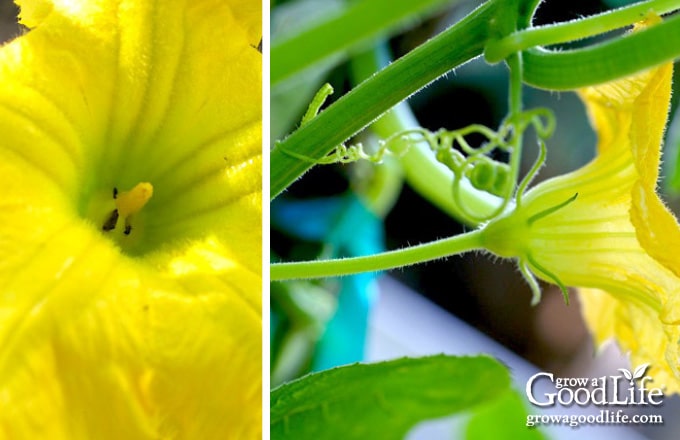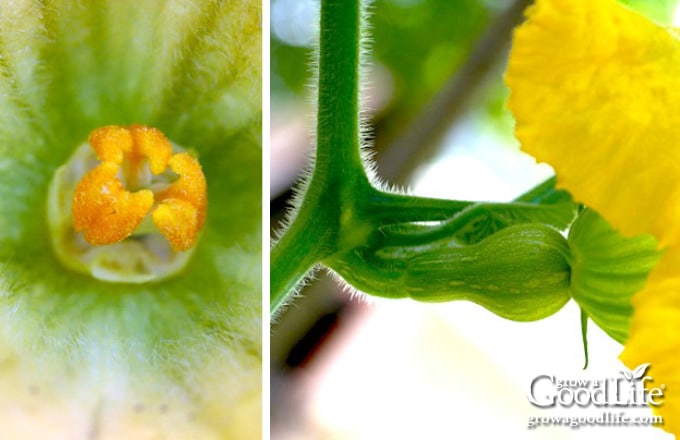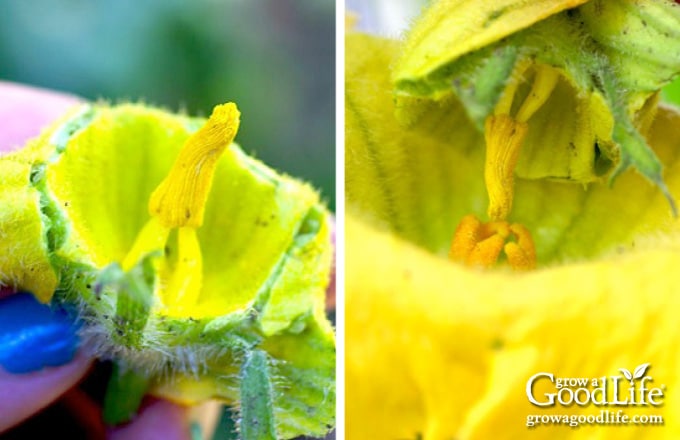How to Hand Pollinate Squash
This post may contain affiliate links, which means that I may receive a commission if you make a purchase using these links. As an Amazon Associate I earn from qualifying purchases.
You may have a lack of pollinators if your squash is filled with blossoms but not growing fruit. If the bees are not doing their job, you can hand pollinate to help your plants produce fruit.

A lack of pollination may be the problem if your plant is growing and blooming, but there is no fruit, or you see baby squash turning brown, withering, and dying on the vine instead of growing.
Don’t worry, you can help your squash by hand pollinating the flowers yourself. This method works for summer squash, zucchini, pumpkins, melons, winter squash, and cucumbers too!
Did you know that all squash plants produce male and female blossoms?
All members of the squash family have male and female flowers on the same plant. The female blossoms grow fruit, but only if fertilized by a male blossom.
Natural pollination occurs when bees and other pollinators visit the male flower, and then the female. As it does so, the bee transfers pollen from the male flower to the female. After pollination, fertilization occurs, and the fruit begins to develop.
Fertilization is necessary for squash fruit formation. If fertilization does not occur, the female blossom will wilt and die. If pollination is successful, the squash will begin to grow.
Reasons Squash isn’t Getting Pollinated
If your plants look healthy with bright green leaves and lots of male and female yellow flowers, but there is no fruit, it may not have been pollinated properly. There are several reasons for poor squash pollination:
- It’s too Early: If your squash has just begun to flower, it is likely that all these blossoms are male. Male flowers form about two weeks before female blossoms. These flowers appear on long slender stems and produces sweet nectar to attract bees and other pollinators.
- Lack of Bees: If your squash is filled with both male and female blossoms, but you don’t see bees around, there may be a lack of pollinators in your area. If bees are not visiting regularly, the fruit will not be pollinated, and will drop off.
- Rainy Weather: Another reason for low pollination may be due to the weather. Cold, rainy, and cloudy weather slows down the pollinators visiting your garden. Not only is it difficult for bees to fly, but damp pollen may not stick as well.
- Not Enough Moisture: Drought conditions will stress the plants and cause young female blossoms to dry up and fall off before opening. Watering your plants when needed will solve this problem.
How to Pollinate Squash by Hand
Instead of waiting for the bees and other pollinators to find your squash plants, you can pollinate squash by hand to speed things up. Hand pollinating squash not only results in an earlier harvest, but also more squash can develop on each plant giving you a larger harvest.
The best time to hand pollinate squash is first thing in the morning just after the blossoms open.
Step 1: Identify the Female and Male Flowers
Male squash flowers appear first to attract pollinators to the plants. About a week or two later, female blossoms should begin to bloom.
Male Squash Flower: At the center of a male squash flower is the stamen. The male flower also lacks the miniature baby fruit behind the bulb.

Female Squash Flower: The center of a female flower has a stigma. On the stem right behind the female flower bulb is a miniature version of the squash that is to be.

Step 2: Apply Pollen from the Male Flower to the Female Flower
There are several ways to accomplish this act. If you’re more on the modest side, you can grab a cotton swab or small paintbrush, rub it on the stamen from the male flower to coat it with pollen, and then rub the pollen onto the stigma of the female flower.
Another way is to use a male flower. First, snap off the male flower from the plant, fold back the flower petals so that the stamen is easily accessible, bring the male flower over to the female flower, and gently rub the stamen on the stigma, transferring the pollen.

If you have several female flowers to pollinate, go ahead and use that same male flower for all of them.
Step 3: Watch Your Squash Grow
Just let nature take its course. Each squash flower opens for only one day, so you will know within days if your pollination intervention worked.
After a couple of days the flower will die and fall off, leaving only the small swelling squash on the stem. If pollinated properly, this baby squash should begin to grow.

If the squash shrivels and falls off, pollination has failed. Squash flowers bloom nonstop through the growing season, so you can try again, and eventually you will succeed.
—
You May Also Like:
- How to Grow Summer Squash Vertically
- 9 Crops to Grow for Food Storage
- How to Harvest, Cure, and Store Winter Squash
Good planning is key to a successful vegetable garden
Whether you are new to growing your own food or have been growing a vegetable garden for years, you will benefit from some planning each year. You will find everything you need to organize and plan your vegetable garden in my PDF eBook, Grow a Good Life Guide to Planning Your Vegetable Garden.


Thank you for such a helpful post! I am growing fall squash for the first time this year and have wet weather just in time for a female flower to open. Hoping for the best!